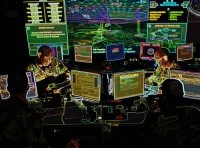
WHAT DID YOU DO IN THE WAR DAD?

Digital conflict has changed the rules of engagement
- Dateline
- 12 December 2050
My grandson was asking about my personal experience in the Vietnam War. He simply cannot understand how we could possibly have lived (and fought) with those primitive technologies. Face-to-face fighting is really a thing of history now, even as conflicts spread alarmingly. Warfare and conflict will never be the same again – digital technologies have permeated every aspect.
Drones have replaced piloted aircraft, tanks and all forms of military vehicles. Ever since human drivers were banned from highways it doesn’t seem quite so strange to the average person anymore. Million-dollar interceptor missiles have been replaced by dollar-a-shot lasers that can take out enemy projectiles faster than any rocket.
Intelligence is gathered by swarms of molecular-sized nano-copters that together can compile live HD 3D pictures that are flashed globally to anyone who needs them. They are viewed and experienced in hyper-reality. It’s more real than being there – except you’re likely to come out alive.
The theatre-of-war is modeled in the minds of machines and orchestrated by youngsters. The term ‘young guns’ has never been more literal. Generals are supported and advised by staffers under the age of twenty who understand the technology, game theory and fractal geometry in a way that the previous generation cannot hope to attain. They multi-task at so many levels that their superiors cannot even grasp. This generation is effectively a new species of Homo sapiens.
‘Physical war’ has really become the action of last resort. Today ‘cyber war’ represents 80% of all global conflicts and is omnipresent, much of it never discovered until it’s too late – and all sides are doing it, completely disregarding the UN’s recent ‘Digital Non-Interference Charter’. It is an unfortunate reality that cyber-war has extended into the physical world, shutting down computer networks, bringing down planes, disrupting nuclear facilities, contaminating water supplies and derailing trains.
Today’s Forbes Magazine rates the ‘Conflict Industry’ as the biggest single industry world-wide for the first time, with the largest research budgets and the highest growth over the last decade. Most of the growth is in high-tech, from robots to drones, from hardware to software, from global hyper-networks in space and on land, to sophisticated cloud servers that put the commercial operations of Google and Amazon to shame.
The Conflict Industry has also created more new jobs than any other industry… but those jobs are not the kind of jobs that my Vietnam-vintage military would recognize.
Physical or cyber-war, the enemy’s body count remains the same.
Links to related stories
- Drone-wrecking laser gun to sail on US warship - New Scientist, 12 April 2013
- How a cyberwar was spun by shoddy journalism - The Guardian, 29 March 2013
- Global Military Spending Dips in 2012 - Military.com, 13 April 2013
- MindBullet: THE BANDWIDTH BUBBLE BURSTS (Dateline: 11 December 2015, Published: 25 October 2012)
- MindBullet: ROBOT ARMY INVADES ZENUTIA (Dateline: 7 April 2016, Published: 22 July 2010)
- MindBullet: US-LED COALITION INVADES IRAN (Dateline: 7 April 2013, Published: 16 December 2004)
Warning: Hazardous thinking at work
Despite appearances to the contrary, Futureworld cannot and does not predict the future. Our Mindbullets scenarios are fictitious and designed purely to explore possible futures, challenge and stimulate strategic thinking. Use these at your own risk. Any reference to actual people, entities or events is entirely allegorical. Copyright Futureworld International Limited. Reproduction or distribution permitted only with recognition of Copyright and the inclusion of this disclaimer.